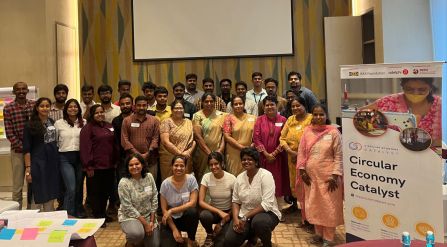CEC is Supporting Circular Economy in High-Potential Regions
| Date |
Date
|

The Challenge in Major Cities: Saturation and Waning Interest
Major cities, particularly in countries like India, have become saturated with entrepreneurship support programmes. While these initiatives are crucial, they create a highly competitive environment for both participants and programme providers. The abundance of options can dilute the focus and motivation of potential participants, as they are often overwhelmed by the sheer number of resources available. This trend can sometimes result in lower-than-expected engagement rates, limiting the potential for sustained impact.
CEC’s data supports this observation. In larger cities, we’ve seen a relatively lower average number of applications per programme, compared to the interest generated in smaller, under-served cities. Moreover, feedback from our Business Development Services (BDS) advisors indicates that commitment levels and show-up rates tend to be lower in these saturated markets.
A Thriving Ground for Circular Economy Innovation
In contrast, Tier 2 and Tier 3 cities are where the market for support programmes is far less saturated. These cities are proving to be an ideal environment for entrepreneurial development. Such regions are characterised by an untapped demand for support systems and a higher level of commitment from participants, who view our programmes as unique opportunities.
For example, in cities such as Coimbatore, CEC has seen a surge in applications, receiving an average over 100 promising applications per training. More importantly, the participants from these regions often demonstrate very strong engagement and a deep commitment to the cause, but likely they have fewer competing opportunities for support and mentorship. Our BDS advisors have noted that participants in these areas tend to be highly motivated and active, driven by the scarcity of resources and a genuine desire to make a lasting impact.
Strong Local Partnerships are the Key to Success
CEC’s success in Tier 2 and Tier 3 cities hinges on the strength of local partnerships. The ability to mobilise local networks is crucial in ensuring the success of our programmes, and this requires deep connections to the local ecosystem. In Coimbatore, for example, we partnered with Idobro Impact Solutions, whose team is well-connected within the university network. This local knowledge and influence helped CEC reach key stakeholders, allowing us to effectively engage the city’s entrepreneurial community.
In other regions, CEC has also established partnerships with universities and local BDS organisations that serve as trusted intermediaries, leveraging their networks to connect with motivated participants. Without these local partners, the ability to identify, reach, and engage with high-potential individuals would be more limited.
Reaching Under-Served Regions
Focusing on Tier 2 and Tier 3 cities has allowed CEC to expand its impact by targeting regions where other programmes are scarce. By prioritising areas with less access to entrepreneurial support, we are able to fill a critical gap in the circular economy ecosystem, enabling a new generation of innovators to drive sustainable solutions. These regions, which can be overlooked by other programmes, are rich in potential and provide fertile ground for the development of circular business models.
CEC’s approach demonstrates that the demand for circular economy solutions is not limited to major urban centres. Instead, it is often in the less saturated, under-served regions where the most enthusiastic and committed entrepreneurs can be found. By focusing our efforts in these areas, we ensure that the circular economy movement reaches the widest possible audience, fostering sustainable development in communities that are eager for change.
Harnessing Untapped Potential for a Greener Future
As we continue to expand the Circular Economy Catalyst’s reach, our experiences in Tier 2 and Tier 3 cities have shown us that these regions represent a crucial part of the puzzle. Their eagerness for support, coupled with the strength of local networks, makes them a powerful engine for innovation in the circular economy. By strategically focusing on these under-served regions we have the opportunity to fill critical gaps in the support ecosystem and help foster the next generation of change-makers.
Our mission remains clear: to empower entrepreneurs everywhere to create sustainable solutions, and to do so by reaching beyond the obvious, into areas where innovation can truly thrive. Tier 2 and Tier 3 cities may be smaller in size, but they offer vast potential for impact.
